Darning Mental Socks: “Mind Fields” at Intermedia Arts
Jay Gabler offers some insight into the artists and issues highlighted by a new show at Intermedia Arts, "Mind Fields," which features work done by artists grappling in some way with mental illness.
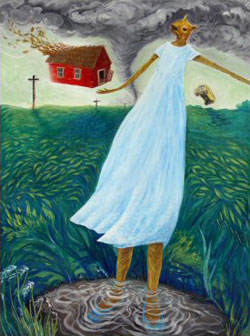
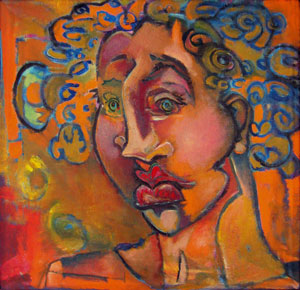
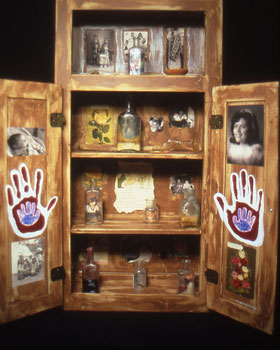
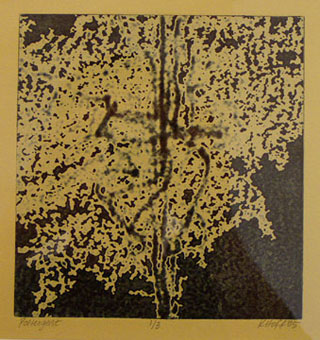
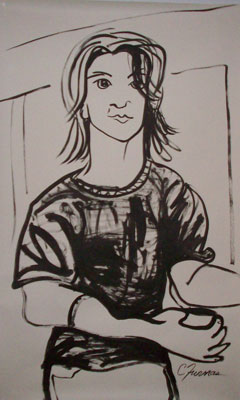
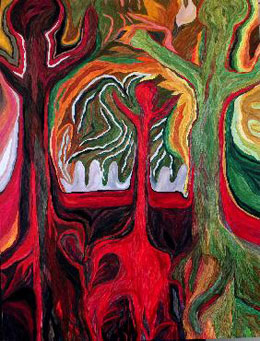
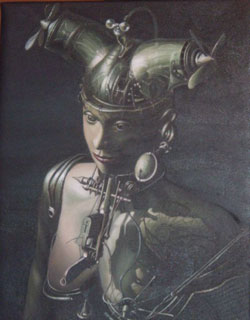
CREATE. ENGAGE. INSPIRE. CHANGE. Intermedia Arts—the Lyndale Avenue headquarters of populist multidisciplinarity—trumpets its credo in large block letters painted on its façade, as though to ward off any doomy cynicism that might drift over from darker corners of the contemporary art scene.
“Art & Healing,” the theme of the organization’s programming from October through December of this year, is consistent with this progressive philosophy. Performances, readings, classes, workshops, discussions, and a gallery exhibit have been mustered to address the relationship between mental illness and artistic expression. The gallery exhibit, titled Mind Fields, features the work of several artists who have been touched in various ways by mental illness.
Bonita Van Moorlehem is an artist who’s also certified as a therapeutic landscaper—that is, a landscaper who crafts gardens intended to facilitate wellness—and she sees art as a balm. “I believe art can be healing. When I paint, I go into a completely different world. It’s an escape.” Mind Fields features several of Van Moorlehem’s paintings depicting the story of her sister Patty, who as an infant contracted encephalitis from a mosquito bite. “For Patty,” says Van Moorlehem, “finally getting her story out in public has been therapeutic. She believes that by telling her story, she can help others.”
The theme of Van Moorlehem’s work is echoed in other artists’ pieces that address the experience of mental illness in a similarly direct manner. In a monologue represented on video, Dean Seal describes his recovery from a brain injury, recounting his frustrations with bitter humor. Missy Whiteman reflects on the effects of a parent’s alcoholism in her sculpture Mother’s Medicine Cabinet. Included in the cabinet’s symbolic freight are glass bottles containing photographs of “memories that my mother drank away,” according to Whiteman’s accompanying statement.
The exhibit’s theme is manifest less explicitly in works by artists who are themselves living with mental illness. Drawings by Dietrich Sieling and paintings by Bridget Riversmith feature surrealistically distorted images—elongated giraffes in claustrophobically tight formation (Sieling), a storm-whipped “part human, part rabbity-squirrely creature” (in the words of artist Riversmith)—but art by its nature plays loose with reality. Should the fact that these artists have experienced mental illness color viewers’ perceptions of their work?
Riversmith, a Duluth-based artist who co-curator Marlina Gonzalez identifies as one of the exhibit’s most important discoveries, declines even to discuss the nature of her illness. “It’s impacted my life greatly to be labeled ‘mentally ill.’ I don’t consider myself a survivor of what’s been called my ‘illness.’ I’m a survivor of the psychiatric industry.” Though enigmatically, Riversmith agrees with Van Moorlehem that the process of creating art can be healing. “Historically, art has always been something that humans have done to keep their mind and body and the world all connected, to record that connection and express it so it’s not forgotten in the everyday pain and fear.”
An entire room of the exhibit is dedicated to Spectrum ArtWorks, a Minneapolis project providing studio space for individuals with mental illnesses. The room includes a wall of Spectrum artists’ work, as well as a timeline tracing the relationship between art and mental illness. The Spectrum community, says co-curator Gonzalez, was adamant that the participants be seen first and foremost as artists—artists who happen to be living with mental illness.
Gonzalez acknowledges the tension between the exhibit’s presentation of art as therapeutic and the simultaneous contention, by some of the participating artists, that mental illness is purely incidental to the process of creating art. “It does seem paradoxical, but we don’t need to have all the answers. Our artists have different approaches, and viewers bring their own personal experiences. We want to open up these discussions, to present different perspectives.”
This is a tension that resonates beyond the specific theme of the Mind Fields exhibit. While art can serve as a catalyst for personal healing or social change, choosing art rather than a more conventional method—like valium or voting—opens the door to a flood of emotions and ambiguities that may challenge the positivist model of progress from “worse” to “better.” In fact, the least ambiguous works in Mind Fields are also the least memorable.
Riversmith and Sieling, by contrast, succeed by conveying a distinct sense of mystery: a sense that they have access to ideas and images that are beyond the average imagination. A recurring motif in Riversmith’s work is a red rabbit that’s haunted her dreams, she says, since as a young farm girl she came upon a skinned, bloody rabbit carcass. “The rabbit’s easy to include because it’s part of my imagination, part of my dreams. I find it easier to draw from that than from the real world.”
Riversmith calls her creative process a “healing” process, but the nature of her process—creating one work after another placing that red rabbit in eerie gouache landscapes and in sculptures of sharp, sparkling aluminum—does not suggest a linear journey from hurt to healed. For Riversmith at least, the healing process is itself the goal. “When I make something,” she says, “I feel like everything comes together. I feel connected, and I can go out into the world and not come apart at the seams. It’s kind of like darning your socks.”
About the writer: Jay Gabler is assistant editor of the Twin Cities Daily Planet. He contributes to publications including The Rake, Rain Taxi Review of Books, and ARP!
What: Art and Healing: Mind Fields
Where: Intermedia Arts, Minneapolis, MN
When: Exhibition runs through January 5, 2008